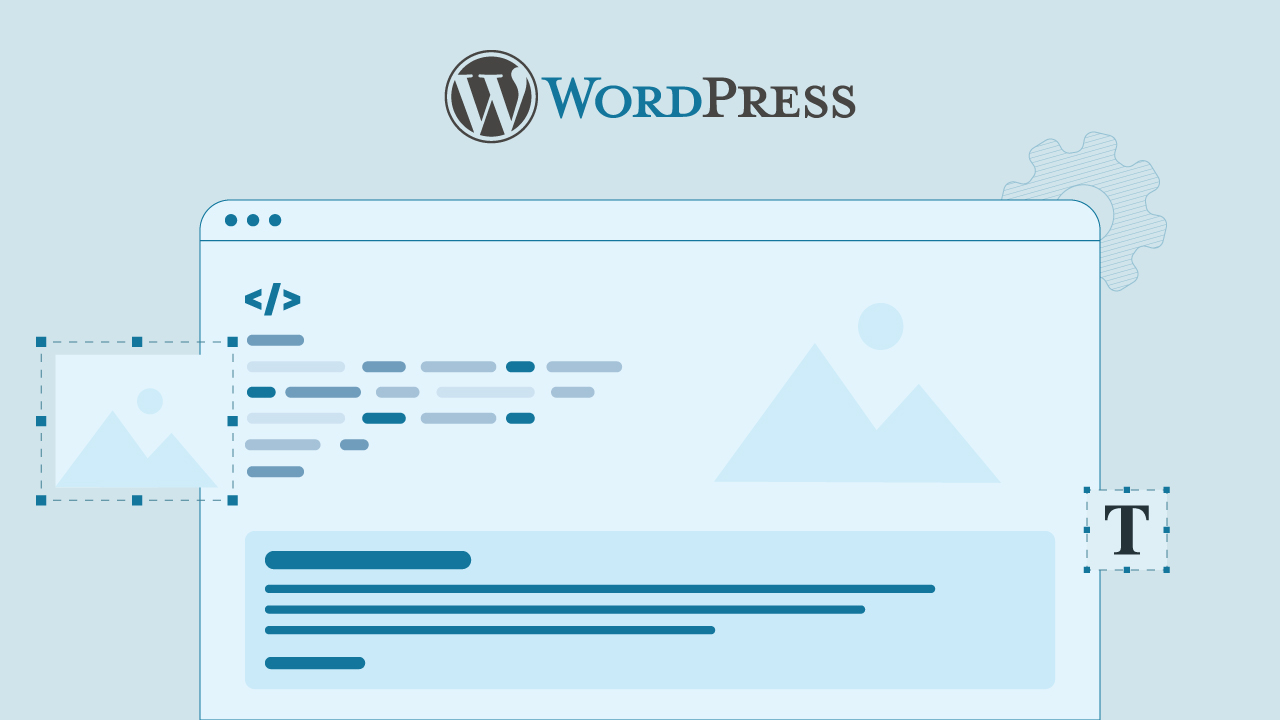WordPress themes come in a wide variety of styles and can be easily switched from within the WordPress dashboard, allowing you to completely transform the look of your website with just a few clicks.
While there are thousands of free and premium themes available in the WordPress Theme Repository and through third-party developers, they may not always perfectly fit your needs.
That is when creating a custom WordPress theme becomes necessary, and you may want to hire a experienced WordPress developer who can design and build a theme tailored specifically to your business’s unique requirements.
Benefits of Creating a Custom WordPress Theme
- Unique Design: A custom theme allows you to create a one-of-a-kind website that stands out from the crowd. You have complete control over every aspect of the design, ensuring your site perfectly reflects your brand or personal style.
- Tailored Functionality: With a custom theme, you can implement specific features and functionalities that your site needs, without the bloat of unnecessary elements often found in pre-made themes.
- Improved Performance: Custom themes can be optimized for speed and efficiency, as you only include the necessary code and features, potentially resulting in faster load times and better overall performance.
- Greater Control: You have full control over the code, making it easier to modify, update, and maintain your site over time without relying on third-party theme developers.
- Learning Opportunity: Creating a custom theme is an excellent way to deepen your understanding of WordPress development, improving your skills in PHP, WordPress core functions, and theme design principles.
- Client Satisfaction: For developers, offering custom themes can lead to higher client satisfaction, as you can create websites that precisely meet your clients’ needs and expectations.
- Easier Compliance: Custom themes make it easier to ensure compliance with web standards, accessibility guidelines, and specific industry requirements.
Prerequisites
Before diving into creating a custom WordPress theme, it’s important to ensure you have the necessary skills, tools, and software. This will make the development process smoother and more efficient.
Required skills:
- HTML: A solid understanding of HTML is crucial, as it forms the structure of your theme’s templates.
- CSS: Proficiency in CSS is necessary for styling your theme and creating responsive layouts.
- PHP: Basic to intermediate PHP knowledge is essential, as WordPress themes heavily rely on PHP for functionality and template structure.
- JavaScript: While not always required, basic JavaScript skills can be helpful for adding interactive elements to your theme.
- WordPress Basics: Familiarity with WordPress core functions, hooks, and the template hierarchy will be beneficial.
- Git (optional): Version control knowledge can help you manage your theme development more effectively.
Necessary tools and software:
- Text Editor or IDE: Choose a code editor that suits your preferences. Popular options include:
- Visual Studio Code
- Sublime Text
- Atom
- PhpStorm (specifically for PHP development)
- Local Development Environment: Set up a local server to test your theme. Options include:
- LocalWP (formerly Local by Flywheel)
- XAMPP
- MAMP
- WampServer
- WordPress: Download the latest version of WordPress from wordpress.org.
- Browser Developer Tools: Familiarize yourself with the developer tools in your preferred web browser (Chrome, Firefox, Safari, etc.) for debugging and testing.
- FTP Client (optional): For uploading your theme to a live server. Popular choices include:
- FileZilla
- Cyberduck
- WinSCP
- Image Editing Software (optional): For creating and editing theme graphics. Options include:
- Adobe Photoshop
- GIMP (free alternative)
- Sketch (for macOS)
- Version Control System (optional): Git is highly recommended for managing your theme’s codebase.
- GitHub Desktop or GitKraken for a user-friendly interface
- Command-line Git for more advanced users
- Theme Testing Tools:
- Theme Unit Test Data (provided by WordPress)
- Theme Check plugin
Our team of experts is ready to help you design and develop a unique WordPress theme. Contact us today to start your project!
How to Create a Custom WordPress Theme (Step-by-Step Guide)
Creating a custom WordPress theme may seem complex at first, but with a systematic approach, it becomes a manageable and rewarding process. By following these steps, you’ll be able to build a theme that perfectly suits your needs or those of your clients.
Step 1: Install a Local Server Environment
To develop a WordPress theme locally, you need a server environment that can run PHP and MySQL. XAMPP and MAMP are popular options.
- Go to the XAMPP or MAMP website.
- Download the version compatible with your operating system (Windows, macOS, or Linux).
- Run the installer you downloaded.
- Follow the on-screen instructions to complete the installation.
- Ensure that Apache and MySQL are selected during installation.
- Open XAMPP or MAMP.
- Start the Apache and MySQL services (usually done by clicking “Start” next to each service).
1.1. Download XAMPP or MAMP:
1.2. Install XAMPP or MAMP:
1.3. Start the Local Server:
Step 2: Set Up a New WordPress Installation
With your local server running, the next step is to install WordPress locally.
- Go to WordPress.org and download the latest version of WordPress.
- Unzip the downloaded WordPress file.
- Move the extracted WordPress folder to the htdocs directory (XAMPP) or the MAMP/htdocs directory (MAMP).
- Open your web browser and go to http://localhost/phpmyadmin.
- Click “Databases” at the top.
- Enter a name for your new_database (e.g., wordpress_db) and click “Create.”
- In your browser, go to http://localhost/wordpress (or whatever you named your folder).
- Follow the WordPress setup instructions.
- Enter your database name, username (root by default), and leave the password blank if using default settings.
- Complete the installation by setting up your site’s title and admin account.
2.1. Download WordPress:
2.2. Extract the WordPress Files:
2.3. Create a Database for WordPress:
2.4. Run the WordPress Installer:
Step 3: Create a New Theme Directory
Now that WordPress is installed, you can start creating your custom theme.
- Go to the wp-content/themes/ directory within your local WordPress installation. For example, if your WordPress is installed in a folder named wordpress, the path would be wordpress/wp-content/themes/.
- Inside the themes directory, create a new folder for your custom theme. Name it something relevant, like my-custom-theme.
3.1. Navigate to the Themes Directory:
3.2. Create a New Folder for Your Theme:
Step 4: Create the Essential Theme Files
Every WordPress theme needs a few key files to work properly.
- Open your text editor (e.g., VS Code, Sublime Text).
- Create a new file and name it style.css.
- Add the following code to the file:
- Save style.css in your theme’s folder (my-custom-theme).
- In your text editor, create a new file and name it index.php.
- Add the following basic template code:
- Save index.php in your theme’s folder.
- In your text editor, create a new file and name it functions.php.
- Add the following code to set up basic theme functionality:
- Save functions.php in your theme’s folder.
4.1. Create style.css:
/*
Theme Name: My Custom Theme
Theme URI: http://example.com
Author: Your Name
Author URI: http://example.com
Description: A custom WordPress theme.
Version: 1.0
*/
4.2. Create index.php:
<!DOCTYPE html>
<html>
<head>
<title><?php bloginfo(‘name’); ?></title>
<link rel=”stylesheet” href=”<?php bloginfo(‘stylesheet_url’); ?>”>
</head>
<body>
<h1><?php bloginfo(‘name’); ?></h1>
<p><?php bloginfo(‘description’); ?></p>
<?php
if ( have_posts() ) {
while ( have_posts() ) {
the_post();
the_content();
}
} else {
echo ‘<p>No content found</p>’;
}
?>
</body>
</html>
4.3. Create functions.php:
<?php
function my_custom_theme_setup() {
// Adding theme support for title tag
add_theme_support(‘title-tag’);
// Adding theme support for post thumbnails
add_theme_support(‘post-thumbnails’);
// Registering a custom navigation menu
register_nav_menus(array(
‘primary’ => __(‘Primary Menu’, ‘my-custom-theme’),
));
}
add_action(‘after_setup_theme’, ‘my_custom_theme_setup’);
function my_custom_theme_scripts() {
// Enqueue main stylesheet
wp_enqueue_style(‘main-styles’, get_stylesheet_uri());
}
add_action(‘wp_enqueue_scripts’, ‘my_custom_theme_scripts’);
Step 5: Activate Your Custom Theme
- In your browser, log in to your local WordPress site by going to http://localhost/wordpress/wp-admin.
- Navigate to “Appearance” > “Themes”.
- You should see your custom theme listed there. Click “Activate” to make it the active theme on your site.
5.1. Go to Your WordPress Dashboard:
5.2. Activate Your Theme:
Step 6: View Your Custom Theme
Go to your site’s homepage (http://localhost/wordpress) to see your custom theme in action. You should see a basic page with your site’s name, description, and any posts you’ve added.
Ready to turn your ideas into a custom WordPress theme? Reach out to us and let’s bring your vision to life together.
Deploying Your WordPress Custom Theme
After developing your custom WordPress theme, it’s time to deploy it to a live environment. This process involves several key steps to ensure your theme functions correctly and performs optimally.
Final Testing:
- Conduct a thorough review of your theme on a staging environment
- Test all functionalities, including responsiveness and cross-browser compatibility
- Use WordPress Theme Unit Test data to ensure your theme handles various content scenarios
Theme Packaging:
- Organize your theme files in a proper directory structure
- Create a compressed . zip file of your theme folder
Upload and Activation:
- Log in to your WordPress dashboard
- Navigate to Appearance > Themes > Add New > Upload Theme
- Upload your theme .zip file and activate it
Post-Deployment Testing:
- Check your live site thoroughly to ensure all elements display correctly
- Test key functionalities like menus, widgets, and custom features
- Verify that all pages and post types render as expected
Performance Optimization:
- Enable caching using plugins like W3 Total Cache or WP Super Cache
- Implement a Content Delivery Network (CDN) for faster asset delivery
- Optimize images and minify CSS and JavaScript files
SEO Considerations:
- Ensure your theme generates SEO-friendly URLs
- Verify that title tags and meta descriptions are properly implemented
- Submit your XML sitemap to search engines
Monitoring and Maintenance:
- Set up uptime monitoring to track your site’s availability
- Regularly update WordPress core, plugins, and your theme
- Monitor site speed and performance using tools like Google PageSpeed Insights
Next Steps for Theme Development
- Continuous learning: Stay updated with WordPress core updates and new web technologies.
- Explore advanced features: Delve into custom post types, taxonomies, and the WordPress REST API.
- Theme frameworks: Consider learning popular theme frameworks like Underscores or Genesis to streamline future development.
- Accessibility: Deepen your understanding of web accessibility standards and implement them in your themes.
- Performance optimization: Explore advanced techniques for improving page load times and overall site performance.
- Version control: If you haven’t already, start using Git for better code management and collaboration.
- Theme customization: Learn how to create theme options and customizer settings to make your themes more flexible.
- Plugin integration: Understand how to integrate popular plugins seamlessly with your custom themes.
- Community involvement: Participate in WordPress forums, contribute to open-source projects, or attend WordPress meetups and WordCamps.
- Consider distribution: If you’re confident in your theme’s quality, consider releasing it on WordPress.org or selling it on theme marketplaces.
Conclusion
Remember, theme development is an ongoing process of learning and improvement. Each project will present new challenges and opportunities to enhance your skills. By continuing to learn and adapt, you’ll be able to create increasingly sophisticated and effective WordPress themes that meet the evolving needs of websites and users.
Whether you’re building themes for personal projects, clients, or public distribution, the skills you’ve learned in custom theme development will serve as a strong foundation for your WordPress journey. Keep experimenting, stay curious, and happy coding!
Skip the complexities of theme development—get in touch with us to craft a tailor-made WordPress theme that stands out.





